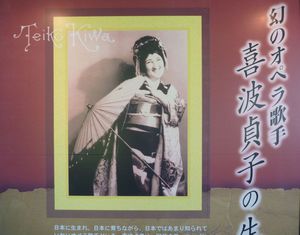Advertisement
Published: November 8th 2011

 Nagasaki
Nagasaki
This poster advertising the original Madame Butterfly, welcomes the visitor ...Ten days weren’t enough to show us all of Japan, but it was enough to explode a lot of stereotypes. Japan has so much to offer that ten days seemed almost an insult, even with first-rate travel professionals to organise the trip. We saw a lot: houses … gardens … temples … galleries … shopping centres … public transport. I quickly let go of a number of inappropriate assumptions I’d taken with me. Here goes ...
Japan is different from the rest of Asia.
Wrong in an important way. It is no more different that all countries are different. Being away from the mainland has encouraged the country to hold onto its traditions. If anything sets it apart, it is that it is fully developed. And that was my first insight: that SE Asian development isn’t moving towards a Western model; it is developing on a Japanese model.
Japanese people are extremely formal and lack humour.
Wrong. Frequent bowing doesn’t seem formal in its natural context. They laugh and smile a great deal and are happy to share humour with inexperienced foreigners. Perhaps the insecurity of being in a foreign culture makes them appear very serious when they are

 Nagasaki
Nagasaki
to Nagasaki with this view over the harbour, looking towards where the 1945 bomb was dropped.in Australia.
The country is so well populated that there is little natural land left.
Wrong and right. Statistics prove that the country is densely populated and there is probably very little “natural vegetation.” But many towns and villages, although close together are small and make a patchwork on the flat land with farms and paddy fields. There are a lot of hills and mountains, all densely forested, with national parks waiting to be walked through.
Their trees grow spontaneously into strange shapes.
Wrong. The trees are pruned into picturesque shapes. This must take many hours of labour in the carefully constructed gardens, both private and public, and parks. Occasionally we spotted a group of trees with their pompoms waiting for a prune.
All Japanese people drive around in small cars.
Wrong. Many of them use bicycles and/or public transport. With such good networks who wouldn’t? It’s easy when a large number of people live close together.
It is difficult for foreigners to negotiate public transport.
Absolutely wrong. Except for the smallest branch lines, trains have recorded announcements in Japanese and English. The maps and signs are also bilingual. Even the Tokyo metro, which appears so

 Arita
Arita
Pruned trees and tour guide in a courtyard garden.complex, proved easy to use right from the start.
Geishas never entertain foreign women.
In our case this was wrong too. We visited a teahouse (the patroness spoke good English) and were entertained for the evening by a maiko and the geisha she is apprenticed to. In this video they perform a dance for the Four Seasons.
How I Travelled
For once, I went on an organised tour, so I'm not offering travel hints here.
Janesco (Japan Tour Specialists) is a small, Sydney-based, boutique travel agency headed by a Japanese lady who has lived in Australia for a couple of decades. She caters to the Discerning Australian Traveller.
It was a ten-day trip, so I had no time to gather personal news. I have put some sketches in
Picassa here. More Information From
All places visited Kumamoto Castle Benesse House Museum Tokyo National Museum .
Advertisement
Tot: 0.174s; Tpl: 0.012s; cc: 13; qc: 67; dbt: 0.0865s; 1; m:domysql w:travelblog (10.17.0.13); sld: 1;
; mem: 1.2mb

 Nagasaki
Nagasaki
 Nagasaki
Nagasaki
 Arita
Arita


































